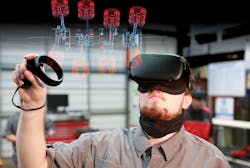With virtual reality (VR) and augmented reality (AR) becoming more commonplace in today’s society, it is important to know the difference between the two.
VR takes users out of where they physically are and creates a new reality somewhere else.
“VR is when you put on the headset and you’re immersed in an environment that is outside yourself,” said Beth Rutter, North American director of industry and customer engagement at Tradiebot Industries. “You’ve taken yourself out of your office or classroom and put yourself into a spray booth or a flight simulator.”
AR, on the other hand, is an interface between your current reality and virtual reality, she said. “You’re standing in a real place in real-time, but you’re overlaying something that’s not with you into that environment.”
A simple version of augmented reality is the QR code, which is usually a square-shaped matrix barcode.
“Most people are familiar with QR codes,” Rutter said. “That’s an augmented reality where you can take a picture of it and call up information.”
For vehicle maintenance, the potential of AR grows, particularly as vehicles become more complicated, noted Rutter, who works in the collision industry. With the right AR program, a technician can point their phone at a truck that needs to be repaired and then see specific repair procedures pop up on the screen.
Think of a rental car company, Rutter said, which has many vehicles on the road, several of which get into small fender-benders.
“Back in the day, that was no big deal,” she recalled. “They would just send them over to the local body shop. They popped the bumper off, stuck some putty on it, shot some color on it, and sent it back at the end of the day.”
Those days are over, though.
“We can’t do that anymore because there are sensors in that bumper,” Rutter continued. “And those sensors are attached to a lot of other things. Taking that bumper off now compromises a whole bunch of other systems in that vehicle. The AR component normalizes that process.”
A modern body shop technician would pull out a phone, take a picture of the vehicle, and run it through a smartphone app that calls up information from the cloud.
“Now, you can look at the vehicle through the camera on your phone—in the app—and it populates with information on the vehicle,” Rutter said. “You’ve got little icons stuck on various parts of the car as you walk around the vehicle. The AR changes as you walk.”
And when the technician working on that bumper touches the icon, it shows where the clips are to remove the bumper, the tools to use, and the repair procedures.
“It might also tell you that you need to disconnect the battery or other related but not necessarily known operations right on your phone,” Rutter added. “From a document standpoint, that’s huge.”
About the Author
Tyler Fussner
Associate Editor | Fleet Maintenance
Tyler Fussner is Managing Editor - Community Manager at Supply Chain Connect, part of the Design & Engineering Group at Endeavor Business Media.
Previously, Fussner served as the Associate Editor for Fleet Maintenance magazine. As part of Endeavor's Commercial Vehicle Group, his work has been published in FleetOwner magazine, as well as Bulk Transporter, Refrigerated Transporter, and Trailer-Body Builders.
Fussner's May 2022 print feature 'The dawn of hydrogen trucks' was named the best single technology article in B2B by the judges of the 2022 Folio: Eddie and Ozzie Awards. Fussner was also awarded Silver in the Technical Article category for the Trade Association Business Publications International (TABPI) 2021 Tabbie Awards.
Fussner previously served as Assistant Editor for Endeavor's Transportation Group on the PTEN, Professional Distributor, and VehicleServicePros.com brands.
Fussner studied professional writing and publishing at the University of Wisconsin-Whitewater. He has experience in shop operations, is a Michelin Certified Tire Technician, and a Michelin Certified Tire Salesperson.

